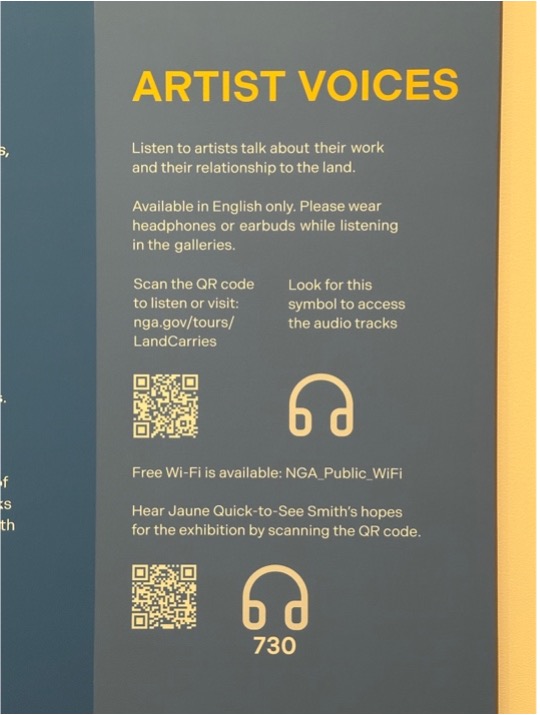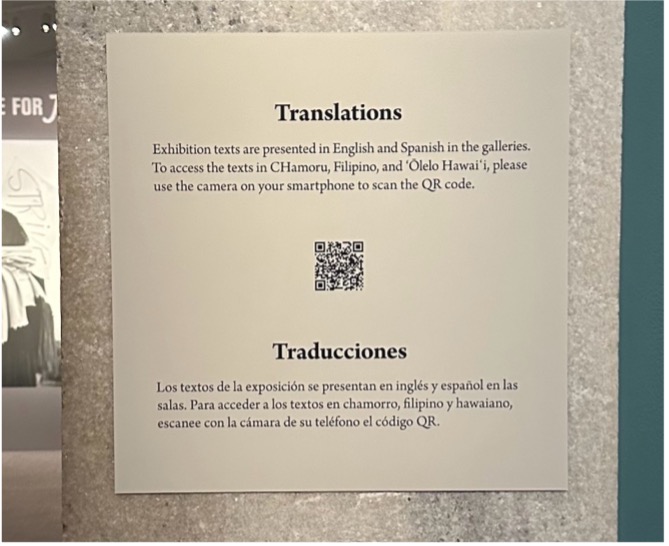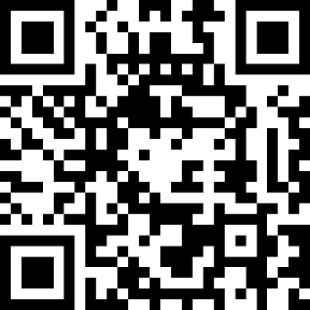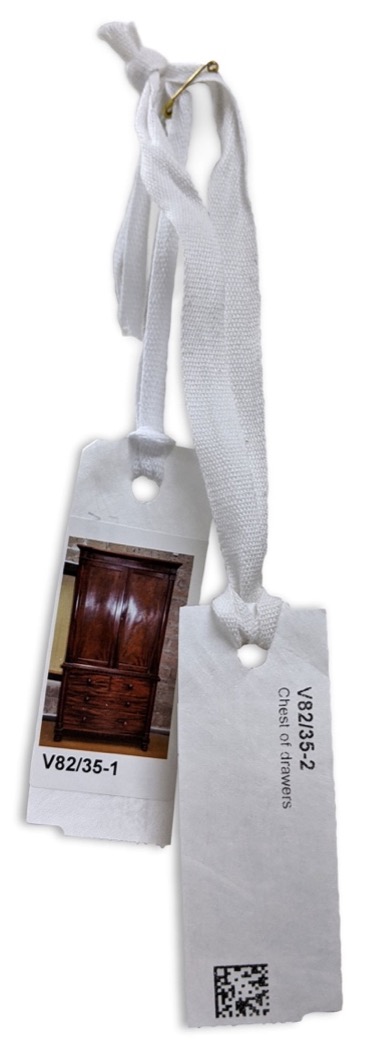The use of barcodes to catalog and inventory collections is a well-established practice in the museum field. The use of QR codes in exhibits to deliver content is likewise a well-established museum practice. The COVID-19 pandemic allowed the numerous uses and capabilities of QR codes to become fully and broadly realized. This research will examine different type of barcodes, the use of QR codes in museum exhibits, and the use of both 1-dimensional and 2-dimensional barcodes in museum collections. Additionally, this research seeks to examine how a shift in museum collections from 1-dimensional barcodes to 2-dimensional barcodes could further promote accessibility and efficiency of collections management.
Definitions
Before getting into the use of 1-dimensional and 2-dimensional barcodes in both museum exhibitions and collections, we first must define these terms. A barcode is a one-dimensional machine-readable representation of data that encodes information into bars and alphanumeric characters. (“Types of Barcodes: Choosing the Right Barcode.” Scandit, August 14, 2023. https://www.scandit.com/resources/guides/types-of-barcodes-choosing-the-right-barcode/.) Barcodes are composed of parallel lines of carrying widths, spacings, and size. This numeric digit code can be scanned with a coherent laser beam, and the reflected light is decoded by the scanner. The deciphered code is then input into a system and calls up information about the object to which the barcode is attached. (Manning, William Albert. “Automated Systems in Museums: The Use of Bar Code Technology in Collections Management.” Museum Management and Curatorship 18, no. 1 (1999): 3-18. https://doi.org/10.1080/09647779900301801.) For example, when checking out at the grocery store, the UPC barcode on the bottom of a bag of potato chips is scanned by the barcode scanner at the register. The scanner reads the numeric digit code, inputs the UPC (Universal Product Code) number into the register, and charges you the appropriate $4.69.
A QR code (Quick Response code) is a two-dimensional machine-readable barcode. A QR code is composed of a series of black and white modules, which represent a bit of embedded data, that run both horizontally and vertically (two dimensional) (“Types of Barcodes: Choosing the Right Barcode.” Scandit, August 14, 2023. https://www.scandit.com/resources/guides/types-of-barcodes-choosing-the-right-barcode/.). These bits of embedded data can be decoded with a scanner, including most smartphones. QR codes have seen major growth over the past 3 years, especially as a result of the COVID-19 pandemic. Museums and other sectors saw a need to minimize high-touch areas, such as restaurant menus and museum signage, to mitigate the further spread of the SARS-CoV-2 virus. The capability of QR codes to connect offline media with online content was an appealing solution to this problem emerging worldwide.
Even as we shift into a “post-pandemic world”, many businesses and institutions still prefer the QR systems implemented during the pandemic. In 2022, it is estimated that 83.4 million smartphone users in the United States scanned a QR code, compared to the estimated 65.7 million in 2020. (“US QR Code Usage Statistics (2019-2025).” Business Insider, July 20, 2022. https://www.businessinsider.com/us-qr-code-user-statistics#:~:text=The number of US smartphone,use and%2C consequently%2C adoption.) QR codes support four modes of data, the two relevant for this research are numeric and alphanumeric data. A key advantage of 2-dimensional barcodes is error-protection formulas, which keeps the data intact and the barcodes scannable even after being damaged. (“Types of Barcodes: Choosing the Right Barcode.” Scandit, August 14, 2023. https://www.scandit.com/resources/guides/types-of-barcodes-choosing-the-right-barcode/.)
QR codes in exhibits
QR codes have been used in museum exhibits for years prior to the start of the COVID-19 pandemic. The first way museum exhibits have used QR codes is to provide additional information about an exhibit and/or artifact. There are many reasons why certain information would be included in a QR code and not on display text. The first reason is simply aesthetic reasons: too much text on a label is distracting and overwhelming. The second reason is because of the nature of some material, whether audio, digital, or another format, which may be more effectively displayed digitally. The Hammer Museum in Los Angeles has implemented additive QR codes in many exhibits, such as the Witch Hunt exhibition, in which QR codes can be scanned for curator commentary videos, and the Made in L.A. exhibit, in which a QR code for “Angel’s Fruits” by Mario Ayala can be scanned and will redirect the user to a YouTube playlist. (Miranda, Carolina A. “The Curse of QR Codes in Museums.” Los Angeles Times, January 22, 2022. https://www.latimes.com/entertainment-arts/newsletter/2022-01-22/essential-arts-qr-codes-in-museums-blessing-and-curse-essential-arts.)
Additionally, QR codes can provide a greater understanding of artist intent and creation process through multimedia content from the artist. In the The Land Carries Our Ancestors: Contemporary Art by Native Americans exhibit at the National Portrait Gallery in Washington, D.C., sign postings (Figure 1) throughout the exhibit redirect museum patrons to audio tracks in which the artists discuss their work and their personal connection to the land. Use of QR codes in this way can transcend the limitations of traditional wall text and provide visitors with deeper understanding of the objects they are interacting with. Beyond appreciation for the objects and/or artwork itself, QR codes can foster a greater connection and appreciation for the artist, their process, and their community.

Another common use for QR codes in museum exhibition is to facilitate self-guided, audio, and multi-lingual tours. This wall text (Figure 2) in the 1898: U.S. Imperial Visions and Revisions exhibit at the Smithsonian National Portrait Gallery has a QR code which redirects visitors to this site, which offers the exhibit’s section text and wall label text in Filipino, ‘Ōlelo Hawai’i, and CHamoru. Multi-lingual tours encourage guests from around the world to fully engage with the exhibit. Virtual tours can also further accessibility for guests who may be visually impaired, hard of hearing, or neurodivergent.

QR codes can also serve as additives to an exhibit through digital assets and collections. Directing patrons to digitized objects allows the experience of getting up close and personal with the object without the conservation and safety concerns. The Galloway Hoard Exhibition was a traveling exhibit of Viking-age objects found in Britain or Ireland. The National Museum of Scotland held this exhibit in the summer of 2021 and developed QR codes for the exhibit, which re-directed users to interactive 3D models and photographs of the exhibit objects. (Coulson , Adam. “QR Codes in Museums - Worth the Effort?” National Museums Scotland , December 1, 2022. https://blog.nms.ac.uk/2022/07/19/qr-codes-in-museums-worth-the-effort/.) The National Museum of Scotland utilized analytic data from the QR codes to determine which digital assets were most popular, and visitor flow through the exhibit. This bird pin was the most scanned 3D object in the exhibit. The Galloway Hoard Exhibition demonstrates how QR codes can foster interdisciplinary collaboration, in this case exhibits and collections, and provide a deeper experience of the institution as a whole to patrons.
However, there are some downfalls to QR codes that are out of the museum’s control. Not every patron will scan all the QR codes, some may not scan a single one. Using analytic data, the National Museum of Scotland states that 65k people visited the Galloway Hoard Exhibition and the QR codes were scanned 26k times. (Coulson , Adam. “QR Codes in Museums - Worth the Effort?” National Museums Scotland , December 1, 2022. https://blog.nms.ac.uk/2022/07/19/qr-codes-in-museums-worth-the-effort/.) Since 2017, QR code reading capabilities have been included in all new Android and Apple software updates.Coulson , Adam. “QR Codes in Museums - Worth the Effort?” National Museums Scotland , December 1, 2022. https://blog.nms.ac.uk/2022/07/19/qr-codes-in-museums-worth-the-effort/. This means that anyone with an updated Apple or Android smartphone could scan QR codes without needing to download a separate app, which was required to read QR codes on most smartphones before 2017. However, not everyone who walks through an exhibit will have access to a capable smartphone. This requires museums to carefully consider which information is essential a patron’s experience and understanding of an exhibit. Museums must strive to enrich the experiences of both the QR-scanning patrons and the non-scanning patrons alike.
The major pitfall of the use of QR codes in exhibits is complete dependency on them over traditional wall text and object labels. In her article for the Los Angeles Times, “The Curse of QR Codes in Museums,” Carolina Miranda describes the oversaturation of QR codes in some museum exhibits. The author recounts a personal visit to the Los Angeles County Museum of Art’s Mixpantli: Space, Time and the Indigenous Origins of Mexico exhibit, in which the only wall text in the exhibit was an opening statement and any information about the artist, object, or region had to be accessed via QR code. (Miranda, Carolina A. “The Curse of QR Codes in Museums.” Los Angeles Times, January 22, 2022. https://www.latimes.com/entertainment-arts/newsletter/2022-01-22/essential-arts-qr-codes-in-museums-blessing-and-curse-essential-arts.) While QR codes can be used to greatly improve access for guests, both disabled and able-bodied, a total dependency on them can also alienate museum guests from connecting with the material and stories being displayed.
Through years of implementation across thousands of institutions, the value and shortcomings of QR codes in museum exhibits are becoming fully realized. The important take away is that QR codes can offer exciting opportunities for museum patrons to interact with the exhibits but should not be completely relied on to deliver information. Rather, QR codes should be used in combination with traditional wall text and object labels to foster truer and deeper connections with the objects. The utility of QR codes in exhibits has been demonstrated time and time again, and 2-dimensional barcodes are starting to demonstrate their utility in museum collections as well.
1-dimensional barcodes in museum collections
“A bar code is part (and not independent) of a larger data management program” (Rose, 2001).
Museums across the world have been utilizing barcodes to label and track their collections decades prior to the QR code “boom” of the 2020s. Scanning the barcode will enter the object’s ID number into the Collections Management System (CMS) and pull up the object record. Based on different institution’s documentation procedures, this record may include photos, donor information, accession records, or past condition reports. While they do not replace traditional artifact labeling, barcodes can enhance the speed, accuracy, security, and cost-effectiveness of recording museum objects. Barcodes can be especially useful when conducting an inventory or moving a collection. Barcodes also remove the margin for human error when entering data; it is estimated that the error rate of barcodes is 1 in 36 trillion. (Simon. “Barcodes: A Helpful Tool for Museum Collections Management .” Arna Botempts Museum, February 10, 2023. https://www.arnabontempsmuseum.com/barcodes-a-helpful-tool-for-museum-collections-management/.)
An effective bar code system includes a system operator (staff), relational collections database, a unique identifying number, a bar code symbology, a bar code translator, a bar code printer, and a bar code reader. (Fishman-Armstrong, Susan E., and Deborah Rose Van Horn. “Considerations for Implementing a Bar Code System in a Museum.” Collections: A Journal for Museum and Archives Professionals 4, no. 4 (2008): 333-48. https://doi.org/10.1177/155019060800400407.) Bar code symbology refers to the many types of 1-dimensional barcodes, with different densities, modes, and dimensions. (Fishman-Armstrong, Susan E., and Deborah Rose Van Horn. “Considerations for Implementing a Bar Code System in a Museum.” Collections: A Journal for Museum and Archives Professionals 4, no. 4 (2008): 333-48. https://doi.org/10.1177/155019060800400407.) Some museum CMS have the ability to generate barcodes, but require an up-charge. One of the main challenges of 1-dimensional barcodes in the museum collections context is the monetary and technology investment required to generate, print, and scan barcodes. The 1-dimensional barcode’s necessary equipment and lack of online capability does not promote growth and access outside of the museum collection.
So, why are Collections Managers so attached to traditional barcodes? It is an established system within many institutions, and many may already have the necessary equipment and software. More so, it is a system which has proven its utility. However, 2 dimensional barcodes in museum collections may boast the same advantages as 1-dimensional barcodes with new opportunities, such as connection to online content and greater access without a specialized barcode scanner.
2-dimensional barcodes in museum collections
“…with the advent of smartphones able to read barcodes scanning is available to anyone, broadening its use from simply cataloguing to communicating” (Sendino, 239).
For many institutions, QR codes are addressing the shortcomings of 1-dimensional barcodes. While barcodes require software to create, printers, and barcode readers, QR codes can be created very easily and freely online. I created the below QR code (Figure 3) which links to the GWU Museum Studies program webpage for free and in under 60 seconds. Likewise, I used my personal cellphone to scan it. A barcoding project with 2-dimensional barcodes may not require software or scanner, but still requires investment in a barcode label printer.

Traditional barcodes can only deliver numeric data, while QR codes can deliver numeric and alphanumeric data. This means QR codes can be used in the same data entry/lookup capacity as 1-dimensional barcodes while also being able to link to online resources and multimedia content. Other features that may make QR codes favorable for use in museum collections include high data capacity, high density recording, high speed scanning, freedom of scanning direction, and advanced error correction. (Sendino, Maria Consuelo. “Use of QR Code Labels in Museum Collection Management.” Collections 9, no. 3 (2013): 239-54. https://doi.org/10.1177/155019061300900302.) In simple terms, QR codes can hold a lot of data in a small area and can be read quickly and easily.
The National Museum of Mongolia undertook a barcoding project in 2016 with funding from the American Center for Mongolian Studies and the United States Embassy in Mongolia. (“ACMS National Museum Barcoding Project.” YouTube, July 19, 2019. https://www.youtube.com/watch?v=KKtrfdfTAeQ.) The museum holds over 230,000 artifacts in storage. Barcoding the collections reduced the time it took for inventory projects from 2-3 years to 4-6 months. The barcode used in this project was a 2-dimensional barcode, such as a QR code, but utilized only to deliver numeric data. This barcode was affixed to a label, which was tied to the object, along with its unique identifying number and name of object. When scanned, the object’s unique identifying number is entered into the museum’s software “Register,” and pulls up the object record, which includes location, origin, material, and storage condition. This project greatly increased the efficiency, access, and organization of the institution’s collection. The National Museum of Mongolia did not utilize the online capabilities of the 2-dimensional barcodes because of the project scope and resources. This project exemplifies the broad usability of 2-dimensional barcodes, which functioned to deliver numeric data like its 1-dimensional counterparts, but still boasting the advantages of 2-dimensional barcodes, such as high-speed scanning.
In 2021, the Museums of History New South Wales undertook a pilot barcoding project at Vaucluse Houses with 2 dimensional barcodes. The institution holds over 46,000 objects and 250,000 archaeological artifacts. Museums of History NSW conducts yearly audits of between 7,500 to 22,0000 objects across 12 sites. (Gloor, Sascha. “Barcoding Our Collection.” Museums of History New South Wales, December 5, 2022. https://mhnsw.au/stories/general/barcoding-our-collection/.) Locating objects across these sites is very labor and time intensive. This pilot project demonstrated the increased efficiency of audit and inventory projects using 2-dimensional barcodes in museum collections. The project barcoded 2,511 objects (over 5% of the museums’ accessioned material) at Vaucluse House and was completed ahead of schedule. (Gloor, Sascha. “Barcoding Our Collection.” Museums of History New South Wales, December 5, 2022. https://mhnsw.au/stories/general/barcoding-our-collection/.) The pilot project covered collections items both in storage and on display. The items in storage were attached with a label (Figure 4), which included the object’s barcode, unique identifying number, name, and photo. Instead of using visible barcode labels on the objects on display, a comprehensive object list with each item’s corresponding barcode was created. When scanned, the barcode connects to the object record on the online collection catalogue and additional information about the provenance, maker, date, and statement of significance. (Gloor, Sascha. “Barcoding Our Collection.” Museums of History New South Wales, December 5, 2022. https://mhnsw.au/stories/general/barcoding-our-collection/.)

The Museums of History NSW’s barcoding project demonstrates the broad application of QR code technology in collections and across institutions. The world of possibilities for two-dimensional barcodes is fully actualized when used to deliver alphanumeric data and connect to online content. The Museums of History NSW’s comprehensive object list illustrates how 2-dimensional barcodes allow the public to engage with artifacts in a new and deeper way. In a sense, QR code technology can bring the artifacts out of the display cases and storage boxes and into the hands of museum patrons.
Conclusion
If something’s not broken, why fix it? When you can make it even better than before! Utilizing barcodes to catalog and inventory collections is old news in the museum world. Collections professionals around the world recognize and demonstrate the benefits of barcoding collections, such as reducing human error when entering data and increasing efficiency during inventory projects. As QR codes have populated the exhibit walls of our museums, collections professionals have begun to deliberate if two-dimensional barcodes may be better suited to their institutions and collections management. A shift from 1-dimensional barcodes to 2-dimensional barcodes will not increase the efficiency of cataloging or conducting inventory. Rather, it is a more cost-effective option for these projects, eliminating the need for specialized barcode scanners and barcode translators. In many ways, QR codes are metaphorically bringing collections objects out of storage. Shown through the Galloway Hoard Exhibition at the National Museum of Scotland and the barcoding project at The Museums of History NSW’s Vaucluse House, QR code technology is allowing museum guests to engage with collection items in new and exciting ways.
Integrating QR code technology from museum exhibits into collections will promote greater accessibility of collection items for research and curiosity alike. Implementation of 2-dimensional barcodes accessible to the public will further promote transparency and accountability of what museums hold in their collections. Utilizing QR code technology in collections will further foster the relationship between an institution and the public it serves. The efficiency of traditional 1-dimensional barcodes has been demonstrated by numerous institutions. While effectively expediting inventory processes, these barcodes have not done much else outside of collections. Bringing QR codes and other 2-dimensional barcodes into museum collections will likewise expedite catalog and inventory projects, while also allowing the artifacts and stories to reach newer and broader audiences.
Bibliography
- “ACMS National Museum Barcoding Project.” YouTube, July 19, 2019. https://www.youtube.com/watch?v=KKtrfdfTAeQ.
- Coulson , Adam. “QR Codes in Museums - Worth the Effort?” National Museums Scotland , December 1, 2022. https://blog.nms.ac.uk/2022/07/19/qr-codes-in-museums-worth-the-effort/.
- Fishman-Armstrong, Susan E., and Deborah Rose Van Horn. “Considerations for Implementing a Bar Code System in a Museum.” Collections: A Journal for Museum and Archives Professionals 4, no. 4 (2008): 333-48. https://doi.org/10.1177/155019060800400407.
- Gloor, Sascha. “Barcoding Our Collection.” Museums of History New South Wales, December 5, 2022. https://mhnsw.au/stories/general/barcoding-our-collection/.
- Manning, William Albert. “Automated Systems in Museums: The Use of Bar Code Technology in Collections Management.” Museum Management and Curatorship 18, no. 1 (1999): 3-18. https://doi.org/10.1080/09647779900301801.
- Miranda, Carolina A. “The Curse of QR Codes in Museums.” Los Angeles Times, January 22, 2022. https://www.latimes.com/entertainment-arts/newsletter/2022-01-22/essential-arts-qr-codes-in-museums-blessing-and-curse-essential-arts.
- Sendino, Maria Consuelo. “Use of QR Code Labels in Museum Collection Management.” Collections 9, no. 3 (2013): 239-54. https://doi.org/10.1177/155019061300900302.
- Simon. “Barcodes: A Helpful Tool for Museum Collections Management .” Arna Botempts Museum, February 10, 2023. https://www.arnabontempsmuseum.com/barcodes-a-helpful-tool-for-museum-collections-management/.
- “Types of Barcodes: Choosing the Right Barcode.” Scandit, August 14, 2023. https://www.scandit.com/resources/guides/types-of-barcodes-choosing-the-right-barcode/.
- “US QR Code Usage Statistics (2019-2025).” Business Insider, July 20, 2022. https://www.businessinsider.com/us-qr-code-user-statistics#:~:text=The number of US smartphone,use and%2C consequently%2C adoption.